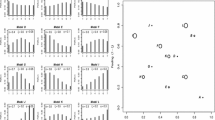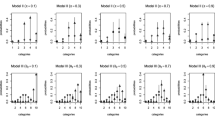Summary
In this article we discuss the identifiability of a probability model which has been proven useful for capturing the main features of ordinal data generated by rating surveys. Specifically, we show that the mixture of a shifted Binomial and a Uniform discrete distribution is identifiable when the number of categories is greater than three.
Similar content being viewed by others
References
Atienza N., Garcia-Heras J. and Muñoz-Pichardo J. M. (2006) A new condition for identifiability of finite mixture distributions, Metrika, 63, 215–221.
Balirano G. and Corduas M. (2008) Detecting semiotically expressed humor in diasporic TV productions, HUMOR: International Journal of Humor Research, 3, 227–251.
Bock R. D. and Moustaki I. (2007) Item response theory in a general framework, In: Psychometrics, (eds. C. R. Rao and S. Sinharay), Handbook of Statistics 26,469-513.
Cappelli C. and D’Elia A. (2004) La percezione della sinonimia: un’analisi statistica mediante modelli per ranghi, In: Le poids des mots — Actes de JADT2004, (eds. Prunelle G., Fairon C. and Dister A.), Presses Universitaires de Louvain, Belgium, 229–240.
Corduas M. (2008) A testing procedure for clustering ordinal data by cub models, Proceeding of the Joint SFC-CLADAG Meeting, ESI, Napoli, 245–248.
Corduas M., Iannario M. and Piccolo D. (2009) A class of statistical models for evaluating services and performances, In: Statistical Methods for the Evaluation of Educational Services and Quality of Products, (eds. M. Bini, P. Monari, D. Piccolo, L. Salmaso), Contribution to Statistics, Springer, 99–117.
D’Elia A. (2008) A statistical modelling approach for the analysis of TMD chronic pain data, Statistical Methods in Medical Research, 17, 389–403.
D’Elia A. and Piccolo D. (2005) A mixture model for preference data analysis, Computational Statistics Data Analysis, 49, 917–934.
Fruhwirth-Schnatter S. (2006) Finite Mixture and Markov Switching Models, Springer Series in Statistics, Springer, New York.
Hennig C. (2000) Identifiability of models for clusterwise linear regression, Journal of Classification, 17, 273–296.
Iann ario M. (2007) A statistical approach for modelling Urban Audit Perception Surveys, Quaderni di Statistica, 9, 149–172.
Iannario M. (2010) Modelling shelter choices in ordinal surveys, submitted for publication.
Iannario M. and Piccolo D. (2009) A program in R for CUB models inference, Version 2.0, available at http://www.dipstat.unina.it
Iannario M. and Piccolo D. (2010) A new statistical model for the analysis of customer satisfaction, Quality Technology & Quantitative Management, 7, 149–168.
McCullagh P. (1980) Regression models for ordinal data (with discussion), Journal of the Royal Statistical Society, Series B, 42, 109–142.
McCullagh P. and Nelder J. A. (1989) Generalized Linear Models, 2nd edition, Chapman and Hall, London.
McLachlan G. and Peel G. J. (2000) Finite Mixture Models, J. Wiley & Sons, New York.
Piccolo D. (2003) On the moments of a mixture of uniform and shifted binomial random variables, Quaderni di Statistica, 5, 85–104.
Piccolo D. (2006) Observed information matrix for MUB models, Quaderni di Statistica, 8, 33–78.
Piccolo D. (2008) Modelling University students’ final grades by ordinal variables, Quaderni di Statistica, 10, 205–226.
Piccolo D. and D’Elia A. (2008) A new approach for modelling consumers’ preferences, Food Quality and Preference, 19, 247–259.
Piccolo D. and Iannario M. (2008) Qualitative and quantitative models for ordinal data analysis, Proceedings of MTISD 2008, Methods, Models and Information Technologies for Decision Support Systems, Università del Salento, Lecce, 140–143.
Teicher H. (1963) Identifiability of finite mixtures, The Annals of Mathematical Statistics, 34,1265–1269.
Titterington D.M., Smith A.F.M. and Makov U.E. (1985) Statistical Analysis of Finite Mixture Distributions, J. Wiley & Sons, New York.
Yakowitz S. J. and Spragins J. D. (1968) On the identifiability of finite mixtures, The Annals of Mathematical Statistics, 39, 209–214.
Author information
Authors and Affiliations
Corresponding author
Rights and permissions
About this article
Cite this article
Iannario, M. On the identifiability of a mixture model for ordinal data. METRON 68, 87–94 (2010). https://doi.org/10.1007/BF03263526
Received:
Revised:
Published:
Issue Date:
DOI: https://doi.org/10.1007/BF03263526




